Solar Heaters
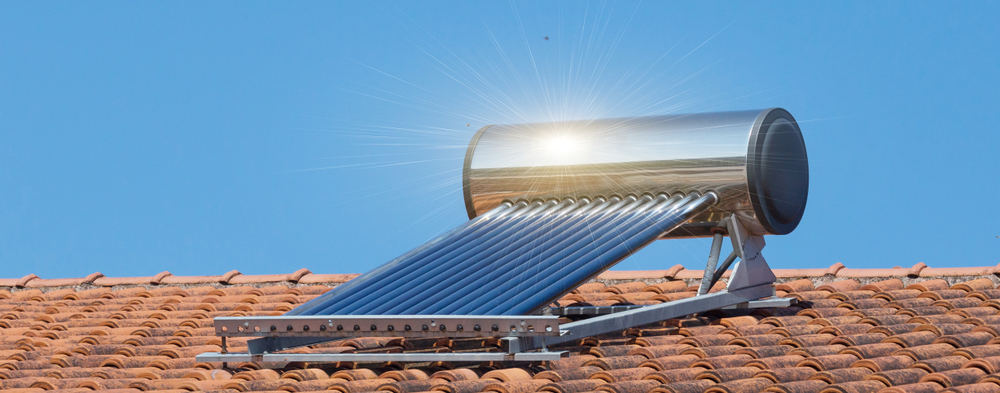
Figure 1: Solar water heater on the rooftop
A solar heater is a device that uses the energy from the Sun to heat air, water, or other fluids. It is an environmentally friendly and cost-effective alternative to traditional heating systems, which rely on fossil fuels that contribute to air pollution and greenhouse gas emissions. This article covers the design and working principle of solar heater water heaters and solar powered space heaters, different types of solar collectors, and the advantages and disadvantages of installing a solar heater.
Table of contents
- Solar water heater
- Collector types used in solar water heaters
- Solar space heater
- Passive vs active solar heaters
- Solar heater advantages
- Solar heater disadvantages
- Applications
- FAQs
Solar water heater
A solar water heater is a device that uses solar energy to heat water. The two main parts of a solar heater are the collector (Figure 2 labeled A) and the water storage tank (Figure 2 labeled G). The collector connects to the water tank through various pipes, as seen in Figure 2. The solar collector faces the Sun. It consists of an array of transparent materials, such as glass, so sunlight can pass through. Environmentally friendly antifreeze runs through tubes in the solar collector to transfer heat energy to the water. The heat from the Sun transfers to the water flowing through the solar collector.
The collector has an inlet pipe that transfers cold water to the collector and an exit pipe that takes the hot water from the collector into the water tank.
The storage tank has four pipe connections, as seen in Figure 2:
- C: cold water from the water tank into the solar collector/pump (pump in the case of an active system and collector in a passive system)
- D: cold water from an external source flowing into the water tank
- E: hot water from the solar collector into the water tank
- F: hot water outlet from the water tank for various applications
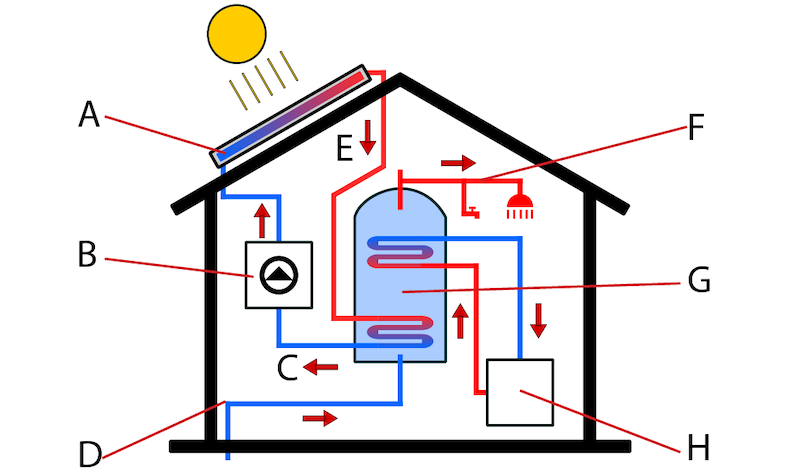
Figure 2: Active solar heater construction: solar collector (A), pump (B), cold water outlet from the storage tank to the pump (C), cold water inlet to the storage tank (D), collector hot water outlet (E), hot water outlet on storage tank (F), storage tank (G), and backup heater (H).
Active solar water heater
Active solar heaters use mechanical means to transfer heat from the solar collectors to the water or fluid. Active solar water heaters are typically more efficient than passive systems and are better suited for larger hot water needs. An external power supply or a photovoltaic solar heat panel powers the pump (Figure 2 labeled B).
Passive solar water heater
A passive solar heater doesn’t use a pump to circulate water through the system. For this process, the storage tank should be installed higher than the solar collector. This is because the solar collector heats the water, which then rises and flows into the storage tank. The height difference allows for the water to flow through the system by gravity. Additionally, a higher water tank helps prevent backflow and contamination of the solar collector.
- The collector traps the Sun’s rays, heating the water within the tubes running through it. Water’s density and mass decrease with temperature. When the water in the collector is hot enough, it moves from the collector to the water tank.
- Hot water occupies the tank’s upper portion, whereas cold water from an external source fills the tank’s lower part. The cold water remains at the bottom due to its higher density compared to the hot water. The water tank is insulated to prevent heat transfer to the surroundings.
- The volume of the water tank is constant. As the hot water enters the water tank, the same amount of cold water flows from the water tank and enters the solar collector for heating. All water movement in the system is controlled by the density differences between the hot and cold water.
Collector types used in solar water heaters
Solar water heaters are described according to the circulation system (passive or active) and the collector type.
- Batch collectors: Batch collectors, also called integrated collector-storage (ICS) systems, heat and store water. The batch collector is plumbed in line with a residential water system. Mains pressure from the water system circulates water through the collector, so a pump is not necessary. Heated water flows from the batch collector to a water heater. Therefore, less energy is necessary to heat the water to desired levels. In fact, in hotter months, the water from the batch collector may be warm enough that the water heater does not even need to run.
-
Flat-plate collectors: A flat-plate collector consists of a plate of heat-absorbing material, typically copper or aluminum, that is painted or chemically etched black. Water runs through copper pipes, called risers, that run lengthwise across the plate. Cold water enters the pipes at the bottom and rises to the top as it heats up. Hot water flows from the collector to a storage tank. The flat plate assembly lies within an insulated box and is shielded by tempered glass.
- Glazed flat-plate collectors are insulated, weatherproofed boxes containing an absorber plate under one or more plastic or glass shields.
- Unglazed flat-plate collectors have a dark absorber plate made of polymer or metal without an enclosure. They are typically used for solar pool heating.
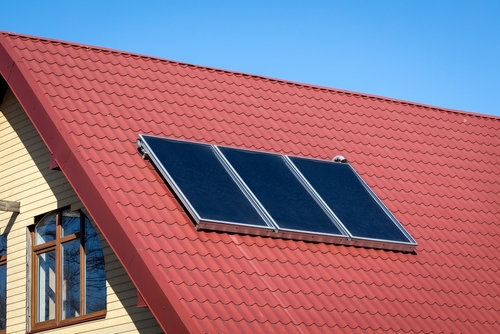
Figure 3: Flat-plate solar collector
- Evacuated-tube solar collectors: Evacuated-tube collectors consist of a glass or metal tube surrounded by a larger glass tube. Heat enters through the larger glass tube and heats up water in the inside tube. The space between the tubes is a vacuum, so the water has minimal heat loss. Evacuated-tube solar collectors are the most efficient collectors available.
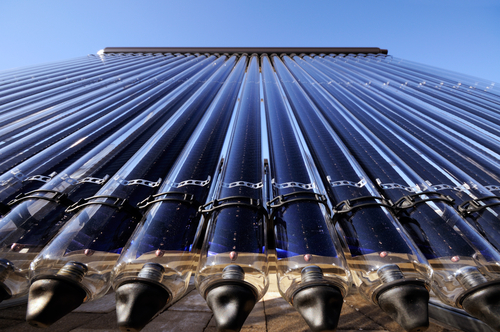
Figure 4: Evacuated-tube solar collector
Solar space heater
Solar space heaters heat the air in a building, providing a source of warmth. There are two types of solar space heaters, passive and active. The working fluid can be either liquid (water or antifreeze solutions like non-toxic propylene glycol) or air. Due to differences in thermo-physical properties of the fluids, their general constructional features may vary, but the basic working principle remains the same. Solar water heaters can also be used with to provide space heating in buildings.
Passive solar space heater
Passive solar space heaters utilize the entire house as a solar collector through strategic positioning and design of both the home and the surrounding landscape. One way of achieving this is by orienting the windows towards the south (towards the north in the southern hemisphere), allowing maximum absorption of the Sun's heat energy. There are multiple designs for passive solar space heaters.
- Direct: A simple method of preserving the warmth generated by solar energy is through the use of thermal mass. This refers to the materials that can absorb and store heat, gradually releasing it as the Sun goes down. Examples of thermal mass include bricks, concrete, and tile floors. The stored heat can be distributed throughout a home through natural processes such as convection, conduction, and radiation.
-
Indirect: A solar wall (Figure 5) is a highly efficient method for well-insulated buildings as it harnesses the power of natural convection to transfer heat from the solar collector to the interior. The solar collector comprises a dark metal absorber that absorbs sunlight and converts it into heat. It is then transferred to the air in the cavity between the absorber and the glazing material (Figure 5). The warm air rises and enters the building through an opening near the ceiling. In contrast, cool air from the interior is drawn into the collector through an opening near the floor to replace the expelled warm air. The passive solar wall has a self-regulating mechanism that adjusts its performance based on the availability and intensity of sunlight, maximizing heat collection during the winter months and minimizing it during summer. Maximum solar energy is collected when the sun is lowest in the sky, i.e., during winter. During spring and fall, less heat is produced. Little, if any, heat is collected in the summer, as the sun is high in the sky. The solar wall collects heat during day time. During night-time, a check valve prevents the backflow of warm building air into the collector. Hence, the solar wall is self-regulating, as the system starts and stops without personal attention.
- Collector materials: Choose transparent and durable glazing materials for solar collectors. Glazing material applied too tightly on a solar collector can cause cracking. To prevent this, corrugated glazing is often used as it allows for flexibility in the material as it expands and contracts. Corrugated PVC is popular for glazing in passive solar walls due to its low maintenance requirements. However, corrugated fiberglass reinforced plastic (FPR) may require more upkeep, as the Tedlar coating used to protect the sheets from UV damage needs to be reapplied every 3 - 5 years.
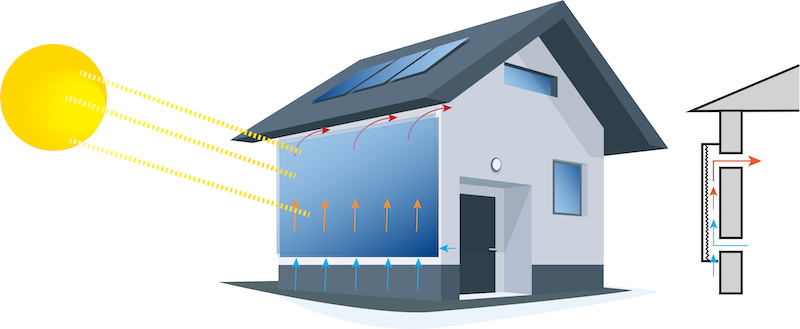
Figure 5: Passive solar air heater
Active solar space heater
Residences with active solar space heating systems use mechanical components like fans, pumps, and blowers to collect, store, and distribute heat throughout the house. The building’s collector array captures the Sun’s energy and converts it to heat. The fan is used to pull air through the solar collector. As the air passes through the collector, it is heated by the energy absorbed by the collector's surface. The hot air is then distributed throughout the room or building using a duct system or a blower.
The distribution system is designed to evenly distribute the heated air throughout the room or building. This can be done using a series of ducts, vents, or registers. The distribution system is typically connected to the fan, which pushes the hot air through the system.
Passive vs active solar heaters
There are three classifications for solar heaters: passive, active, and a combination of both. Passive systems depend on natural convection and radiation, while active systems use mechanical or electrical means to circulate heat. Passive systems are more affordable and less complicated than active systems but may not be suitable for areas with lower solar radiation levels. In such cases, active systems are the best option for retrofitting a building to harness solar energy.
Solar heater advantages
- Cost savings: Solar heaters have a higher initial investment cost than traditional heaters. However, they can significantly reduce energy costs using free solar energy instead of fossil fuels. They also have a longer lifespan than conventional heating systems, which further reduces maintenance costs. Solar water heaters typically have the fastest investment repayment in 2 - 4 years, depending upon use and the fuel replaced.
- Environment-friendly: Solar heaters do not produce greenhouse gasses or air pollution, making them more sustainable and eco-friendly.
- Reliability: Passive solar heaters do not rely on electricity or gas, making them more reliable in power outages or gas shortages.
- Versatility: Solar-powered heaters can be used in various commercial and domestic applications like heating swimming pools, domestic purposes, and several industrial processes. A portable solar heater can be installed just about anywhere.
Solar heater disadvantages
Solar heaters may not be suitable for climates with prolonged cloudy weather, as they rely on sunlight for heat generation. They are typically installed in milder climates where temperatures do not drop extremely low, as outdoor pipes can freeze in cold weather. Additionally, solar heaters have a higher initial cost than traditional heating systems, but can offer long-term energy savings.
Applications
Solar thermal technology is continuously evolving, and new indoor and outdoor applications are being developed daily.
- Space heating: Solar room heaters can heat a room and indoor solar heaters can heat an entire building by absorbing sunlight and converting it into heat energy.
- Water heating: Solar heaters for home can heat water for household use, such as for showers or laundry.
- Pool heating: Solar heaters can heat swimming pools, allowing for extended use in colder months.
- Industrial process heating: Solar thermal systems can heat air or fluids for industrial processes, such as drying crops or manufacturing.
- Cooking: Solar ovens use the heat from the sun to cook food, eliminating the need for electricity or gas.
- Drying: Solar heat can dry clothes, agricultural products, and other goods.
Read our articles on radiant floor, electric infrared, and portable heaters for more details on the working for various heater types.
FAQs
What is a solar-powered heater?
A solar heater is a device that uses the energy from the sun to heat air, water, or other fluids. They are used for various applications, including space heating, water heating, and industrial processes.
What are some outdoor solar heater applications?
If you have a chicken coop, you can use a solar heat lamp. A solar camping heater can keep your tent warm during the night. For heating a shed, a solar heater for shed is a good option.
Can solar energy be used for cooling?
Yes, solar thermal energy can be used to drive absorption refrigeration cycles to provide solar heating and cooling in buildings and other applications.



